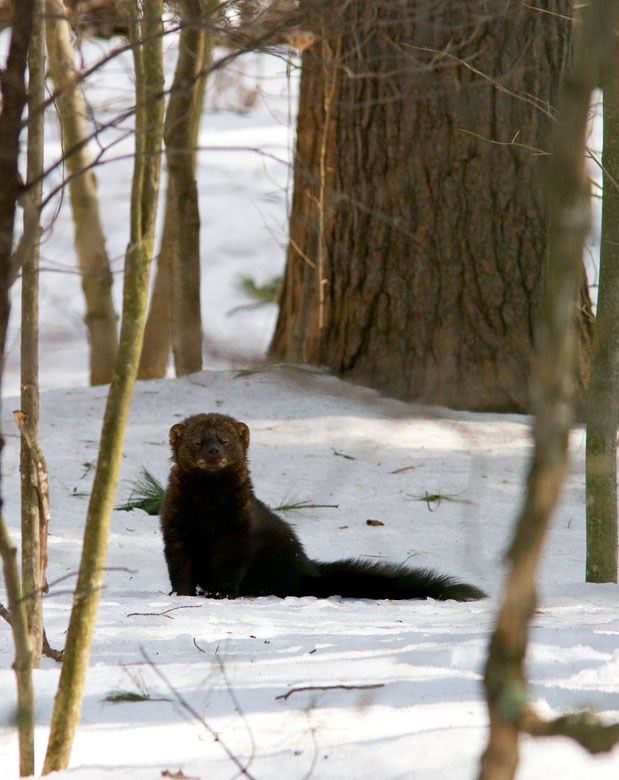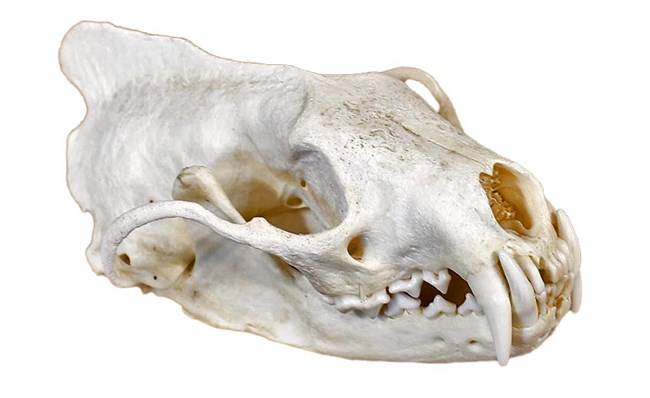Last updated: August 15, 2021
Article
NETN Species Spotlight - Fisher
A porcupine slowly waddles its way the short distance from its den to its favorite hemlock tree for some winter foraging. Shrouded in a protective shield of nearly 30,000 quills, each tipped with a microscopic harpoon-like barb, most would-be predators know better than to attempt a foolhardy attack to make a meal of this large member of the rodent family. But today is different - with a flash a fisher seemingly flies out of nowhere and slashes at the porcupine’s face. Stunned but focused, the prickly prey tucks up face-first against the base of the hemlock and presents it arsenal of quills towards its attacker. This is enough to ward off most animals, but with lightning-quick speed the fisher jumps over the porcupine onto the tree. Possessing the ability to turn its rear feet almost 180 degrees, the large weasel faces down the trunk of the tree and again slashes at the porcupine’s face. Having exhausted its bag of tricks to escape, the rodent begins to black out after several more fisher attacks. It’s last sensation is being rolled over by the fisher, who is about to enjoy a well-earned meal.

Ed Sharron
What is it?
An important part of the lore of the Northwoods, fishers are a large member of the weasel family in the northern part of the US and into Canada. Adult females weigh about 4-6 pounds and adult males about 12-14. Fully grown males can be nearly 4-feet long, though much of that is its long tail. That tail is also the reason it is often referred to colloquially as a “fisher cat”. Despite this, they have no relation to felines and they rarely dine on fish. The name “fisher” likely stems from a lost-in-translation corruption of the French fur-trappers name for them centuries ago. To them, our native weasel’s fur appeared similar to European polecat (a wild ferret) fur for which the French word is fichet or ficheux.Fishers are very capable predators. Armed with agility, speed, sharp teeth and claws, and boundful energy, they lope throughout their territories through places where they know squirrels, mice, voles, birds, rabbits, hares, and even porcupines may be active, hoping to flush something out and chase it down with its speed. They can follow prey into tight spaces like underground tunnels or snow passages and take them down with a bite to the back of the neck. Their fierce reputation is often undeserved when compared to any other wild animal that hunts to survive, or even compared to a house-cat that toys with its prey before killing it.
Why is it important?
Forested ecosystems that include a healthy fisher population are a positive sign of a well-functioning, mature environment. Fishers also help control rodent populations, both large and small species, and have been reintroduced in some parts of the country to help keep in check forest-stand damaging porcupines. They increasingly appear to be filling, at least partially, a niche left vacant when top-tier predators (wolves and mountain lions mostly) were extirpated from the region.
Ed Sharron
How does NETN monitor it?
The NPS I&M Northeast Temperate Network's (NETN) vital sign monitoring programs don’t directly monitor fishers, but the forest health monitoring program provides data that can be a good predictor of suitable habitat for the animals. NETN staff also leads winter wildlife tracking programs with the public and area schools that frequently encounters the tracks of these animals in Vermont and New Hampshire.How is it doing?
Fishers have made a strong comeback in recent years and these medium-size mustelids are repopulating old territory after centuries of absence in some cases. Even far from cities, it was essentially vacated from the Northeast by the 1930’s and 40’s due a killer combination of habitat loss and high trapping pressure for its valuable pelt. As forests have recovered in the region and trapping activities have abated, the fisher population has naturally rebounded. In the eastern U.S., fishers have grown their range by an impressive 119% since the early 1900’s – one was even seen in New York City a few years ago. Some scientists think that fishers, among other mid-level predators, are benefiting from what is termed “mesopredator (medium-sized predator) release”. Researchers are pondering if expanding fisher populations in the region are resulting and benefiting from the absence of large carnivorous predators and their direct predation and competition. Interestingly, this could even be influencing changes to fisher’s morphology and ecological niche-fulfilling role. One study in particular found fishers in the east are complementing their already diverse diets with more relatively large-bodied prey species, as opposed to populations with specialized diets (northwestern fishers) or diverse diets with small amounts of large-bodied prey (California) that have seen little range expansion over the last few decades.
Another trait that is benefitting the expansion of these animals is that they are highly adaptable. Human developments present many challenges (road-crossings, dogs, hunting, trapping) but also many opportunities (bird feeders, farm fields, road-kill, and squirrel-laden parks). Their comeback and range expansion into unexpected places like cities and busy neighborhoods speaks to their resiliency and adaptability to modern conditions. Whereas not long ago, to catch a glimpse of these animals was an extremely rare treat - today more and more people are having a chance to lay eyes on this amazing animal.
For more information
See NETN’s forest health monitoring protocols, reports and resource briefs available from the Forest Health page of our website.Tags
- acadia national park
- appalachian national scenic trail
- eleanor roosevelt national historic site
- home of franklin d roosevelt national historic site
- marsh - billings - rockefeller national historical park
- minute man national historical park
- morristown national historical park
- saint-gaudens national historical park
- salem maritime national historical park
- saratoga national historical park
- saugus iron works national historic site
- vanderbilt mansion national historic site
- weir farm national historical park
- fisher
- weasel
- porcupine
- netn
- species spotlight
